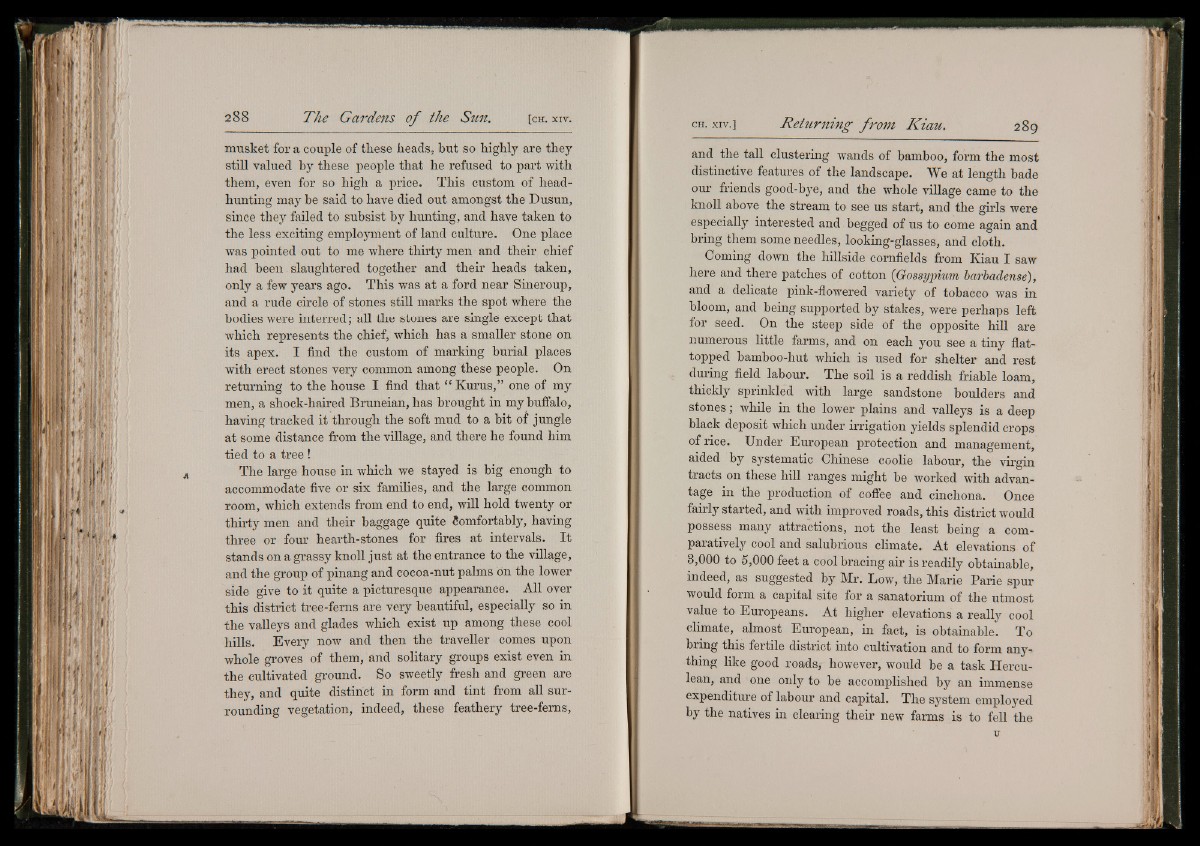
musket for a couple of these heads, but so highly are they
still valued by these people that he refused to part with
them, even for so high a price. This custom of headhunting
may be said to have died out amongst the Dusun,
since they failed to subsist by hunting, and have taken to
the less exciting employment of land culture. One place
was pointed out to me where thirty men and their chief
had been slaughtered together and their heads taken,
only a few years ago. This was at a ford near Sineroup,
and a rude circle of stones still marks the spot where the
bodies were interred; all the stones are single except that
which represents the chief, which has a smaller stone on
its apex. I find the custom of marking burial places
with erect stones very common among these people. On
returning to the house I find that “ Kurus,” one of my
men, a shock-haired Bruneian, has brought in my buffalo,
having tracked it through the soft mud to a bit of jungle
at some distance from the village, and there he found him
tied to a tree !
The large house in which we stayed is big enough to
accommodate five or six families, and the large common
room, which extends from end to end, will hold twenty or
thirty men and their baggage quite Comfortably, having
three or four hearth-stones for fires at intervals. It
stands on a grassy knoll just at the entrance to the village,
and the group of pinang and cocoa-nut palms on the lower
side give to it quite a picturesque appearance. All over
this district tree-ferns are very beautiful, especially so in
the valleys and glades which exist up among these cool
hills. Every now and then the traveller comes upon
whole groves of them, and solitary groups exist even in
the cultivated ground. So sweetly fresh and green are
they, and quite distinct in form and tint from all surrounding
vegetation, indeed, these feathery tree-ferns,
and the tall clustering wands of bamboo, form the most
distinctive features of the landscape. We at length bade
our friends good-bye, and the whole village came to the
knoll above the stream to see us start, and the girls were
especially interested and begged of us to come again and
bring them some needles, looking-glasses, and cloth.
Coming down the hillside cornfields from Kiau I saw
here and there patches of cotton (Gossypium barbadense),
and a delicate pink-flowered variety of tobacco was in
bloom, and being supported by stakes, were perhaps left
for seed. On the steep side of the opposite hill are
numerous little farms, and on each you see a tiny flat-
topped bamboo-hut which is used for shelter and rest
during field labour. The soil is a reddish friable loam,
thickly sprinkled with large sandstone boulders and
stones; while in the lower plains and valleys is a deep
black deposit which under irrigation yields splendid crops
of rice. Under European protection and management,
aided by systematic Chinese coolie labour, the virgin
tracts on these hill ranges might be worked with advantage
in the production of coffee and cinchona. Once
fairly started, and with improved roads, this district would
possess many attractions, not the least being a com-
paratively cool and salubrious climate. At elevations of
3,000 to 5,000 feet a cool bracing air is readily obtainable,
indeed, as suggested by Mr. Bow, the Marie Parie spur
would form a capital site for a sanatorium of the utmost
value to Europeans. At higher elevations a really cool
climate, almost European, in fact, is obtainable. To
bring this fertile district into cultivation and to form anything
like good roads, however, would be a task Herculean,
and one only to be accomplished by an immense
expenditure of labour and capital. The system employed
by the natives in clearing their new farms is to fell the